Auntie Winnie's Hands
Saturday, February 20, 2010
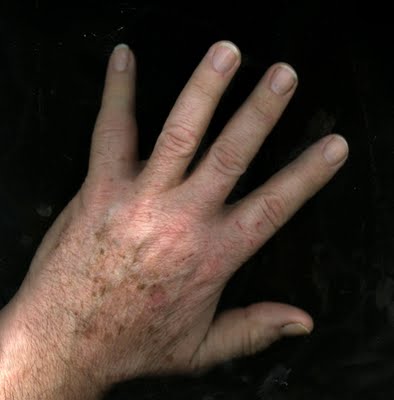 Lolita has been on my mind of late simply because I happen to be reading The Annotated Lolita by Vladimir Nabokov, Edited with Preface by Alfred Appel Jr. As to why I am reading it my readers here may have to wait a couple more days for a full explanation. I mention Lolita because the idea of an older man interested in young girls is an experience I have never had. When I was interested in 12-year-old girls I was 10 or 12. I have never felt much of an attraction for a woman much younger than I. And as I get older that gulf seems to get wider. The voices of the announcers of the young females on CBC Radio sound like Canadian variations of Valley Girls of yore. They don’t excite me. Give me Barbara Budd from As It Happens if you want to get any kind of a rise from me. I am not interested in re-gaining my youth through interaction with a young woman or a young girl. It seems that a young blonde girl (in combination with a bright red Mazda Miata) is supposed to give the aging man a sense of a new-found youth. I have never felt that. For me it has been quite the opposite. Many years ago in the beginning of the 70s I was teaching a grade 12 class in a Mexico City private school. I would often say to my class, “I feel so young when I face you.” One day I was taken to task and one of my students said, “That must be because you are surrounded by youth.” My reply shocked them, “No, it is because I am surrounded by prematurely old people set in their ways who must practice all kinds of self-imposed regulations (particularly dress ones) to feel that they fit in.” I have often wondered why politicians such as Winston Churchill became more conservative with age. I always thought that one could risk more when time is short. And yet there were people like Bertrand Russell and Linus Pauling who became more liberal and forward thinking as they aged. I mention this as one of my blog follwers sent me a missive suggesting that I was stressing much to much the "age thing". Quite to the contrary I want to point out all the advantages. About a month ago I lost all the data on a hard drive. It included a year's worth (2009) of plant scans and a Power Point presentation that my granddaugther Rebecca and I did at the World Rose Convention back in June. I was devastated. But I noticed that as days became weeks the sense of loss was diminishing to the point that I did not feel the loss at all. When John from Powersonic (in Richmond) called to say, "I have retrieved the data (including those plant scans and the Power Point Presentation) from that drive. It will cost you $600." I felt like saying, "John it is not important at all, anymore. Few things at my age are and that's good!" It did not come as a shock to me when last week at a birthday party at an East Broadway Japanese restaurant honoring my friend Charles Campbell ( a sort of snobbish “I protest the Olympics” sort of party as it began at 7 pm the day of the opening ceremonies) when another friend Maja Grip told me, “For the first time I see that you are aging.” I felt like countering with a kind reply (kind replies come with age) in which I would have said, “For someone your age who never flaunted her charms you are showing today a fair amount of very attractive cleavage.” It was about 5 years ago that I had a model that I have photographed many times during the years come into my studio. She was a beautiful woman who in the last 10 years has cut her lovely hair and worn clothing she would have never worn before. It is almost as if she wanted to hide her beauty to be accepted for who she is. I would argue that individuality is what makes us be me and not her and part of that individuality is how we look. A world of look-alike clones would be a most confusing one. As I was adjusting my camera settings she looked at my hands and gasped. “What is it?” I asked. She said nothing. I knew that she had noticed my weathered/age/garden hands and suddenly noticed that I was a much older man. It could have been that my hands were an equivalent to looking at herself in the mirror. Hands have always been important in my life. I remember my father’s strong but small and elegant hands stained by his Player’s Navy Cut cigarettes. I remember my mother’s beautiful piano hands with long slim fingers and immaculate finger nails. She also had beautiful feet which I inherited. Alas I did not inherit her hands but until that model had noticed my hands in the studio I had always bragged about my gentleman’s hands. They were hands that were soft and uniform in colour with nicely kept nails. I bragged that I didn’t have the hands of a ditch digger. But garden work and particularly the caring for my beloved roses have changed that. Just the pruning of a viciously endowed rambler, Rosa ‘Albertine” a few days ago has left my hands with scratches, wounds and festering sores. Rosemary cannot remember when it exactly happened that she stopped being able to trim the nails of her right hand. She comes over to my side of the bed (the left side) and sits on the edge so I can trim her nails (anybody out there, a small portable hand vacuum would make an excellent Christmas present). I have few memories of my father’s older brother, my Uncle Harry and his wife Winnie. One involves a nighttime dinner at their Acassuso home in Buenos Aires. I could smell Uncle Harry’s predilection for tobacco and alcohol as I watched him whip up some Colman’s mustard. I may have been 7 or 8 but I did notice that he put in a teaspoonful of sugar into the mixture. His hands were big. They looked like a working man's hands. Last year my first cousin Willoughby Blew came to visit us with his wife from Florida. He watched me put sugar into my Coleman’s (now Keen’s) powder and said, “Just like Uncle Harry used to make it.” It is the other memory of my Auntie Winnie serving us tea in her quintessential English dining room on a sunny afternoon when I noticed her disfigured hands. She could barely lift the tea pot to serve us tea. I have no other image of Auntie Winnie. Her face is a blur but her hands are as sharp in my memory now as the shock of seeing them as a little boy then.  That memory is reinforced every night when I sleep. I move around and my hands get caught under the pillow. My pinkies throb. I have arthritis. At my rate I will soon not be able to prune my roses as the secateurs will be unmanageable in my hands. But I know for sure I will still be able to stir in that sugar into my mustard. If anybody were to ask me precisely what my style is when I shoot my portraits I would answer, “I like eye contact with my camera and I always try to incorporate my subject’s hands. After our face, our hands reveal the most about us.”
The Dithering Photographer And His Clones
Friday, February 19, 2010
 About 10 years ago three photographers (I was one of them, and one of the others was a woman who also became one of my subjects) had a project which we repeated three times. It started at a downtown café called Subi’s. I told the other two that we would pick a fairly attractive female and bring her to the studio for a group shot. Then during a month each one of us would photograph her and make sure that none of us were aware of what the other was doing. At the studio I would plainly tell our subject, “If at any time any of us ask you to undrape you must do it. If there is any objection to this, tell us now.” Then we would have a one night show in my studio. One of our subjects Corrie Clark reneged on our instructions and I had a hard time (I succeeded in the end) in making her undrape. It took me years to go through the normal channels of not knowing how to convey to my subject that I wanted her to take it all off. I had not discovered the direct approach nor was I aware that for every photographer that wants to have the model take it all off there is a large multitude of subjects who will readily volunteer if asked. With one model in particular I was particularly indirect and obtuse. I dithered around taking pictures that were not satisfying me in the least. Finally my model said, “Is this what you really want?” and she lowered the straps of her slip and exposed her breasts. I blushed and took my pictures. Since that one time I have learned to put my cards on the table. There was one young woman who told me, “You can only photograph 25% of this and you can only go as far down as here. I turned off my lights and told her that she could go. In another occasion I had two very beautiful young women in my studio and to break the ice I told them, “I have two daughters who are both older than both of you. I am not in the least interested in you except as my photographic subjects. I prefer women my age and that is why I am attracted to my wife. I just want to take your pictures.” They looked at each other and walked out of my studio. Since then I have been ambivalent about being direct and in some cases I have chosen to say less and take more pictures instead. Of late, without my studio, I have given the whole process some thought. I occasionally teach a nude portrait class at Focal Point and with my instructions my students become my surrogates and take pictures my style. This led to one of my students saying to me in the presence of my other students, “What you want to do is to turn us into little Alexes.” He got up and walked out and never did return. It had all begun when my student had projected some pictures which we critiqued. One of our models had been slightly on the large size. I always tell my students that it is our obligation to make people as good as we can and if possible even better. A lot of this can be done with lighting and camera angles. The moving of the body can diminish neck folds (anathema!) and I tell my students I don’t want to look at armpit folds (double anathema!). The student in question did nothing to hide the model’s pendulous breasts. I pointed this out and was told that there was nothing wrong with pendulous breasts. I asked one of my female students if she would be happy with pictures that showed her breasts as being like that. She agreed that she would not be happy. To finish the argument my student said, “We pay the model. We can make her look anyway we want.”  It is in such times that I feel like picking up sticks and moving to Trelew in Patagonia and learn to speak Welsh. But that is not a viable option at this moment. I photographed María de Lurdes Behar three times. The third time she was one of my tub women for a show. The first time around I took pictures when I was still in the height of my dithering period. It was 1990. After some exposures I finally came up with enough nerve and most of her clothes were discarded. Some of these pictures are extraordinarily beautiful. Because my intention was always to photograph the model undraped I never did look at the pre-undraped exposures with any interest, until now. At my age I find my drive (that one!) is diminishing and my idea of what is erotic is more in the direction of subtlety. Clothed, is now suddenly much more interesting. I found a couple of pictures of María de Lurdes which I think are beautiful. I hope that anybody looking at them might just agree.
Thursday, February 18, 2010
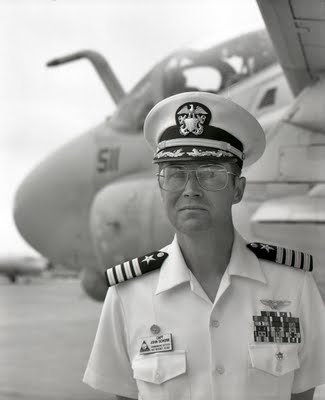 Guest Blog NAS Whidbey Airshow … Rossiter… 15 August 94 Former Navy pilot Stephen Coonts is working on a follow-up to his novel Flight of the Intruder, from which Paramount Pictures derived the popular Vietnam action movie in which a Navy A-6 crew decide to buck the president’s bombing guidelines and attack Hanoi. Coonts’s novel contains some of the best evocations of military flying since Pierre Closterman’s WWII memoir The Big Show appeared in 1951. Both books remove the romantic veneer from the war in the air, at least partly because bombing is so much more dangerous and morally ambiguous than air-to-air combat. The movie was distributed to carrier air groups during the Gulf War, when it might have been expected to boost morale. It was, after all, the first depiction of the nerd of carrier aviation, Grumman’s A-6 Intruder. To real-life A-6 flight and ground crews, though, the flyboy caricatures they saw of themselves were a grave slight. Like most aviation pictures, Flight of the Intruder is in trouble as soon as the action returns to the carrier deck. Maybe Paramount will do better with Coonts’s new book The Intruders. The actual A-6 community is more complex is infinitely more interesting than director John Milius’ portrayal. Certainly more professional. Capt. John Schork’s bomber-pilot war stories are less about combat than accounts of the ongoing battle with fear of celebrations of sheer technique. Peace stories you might call them. The Naval Air Station Whidbey Island’s executive officer, Commander Joe Nortz (think of the Tom Skerritt character in Top Gun but with fewer wrinkles), had promised us war stories. Not only would we hear war stories, but the guy telling them would be the base commander. NAS Whidbey’s CO, Schork flies more than a desk. He has flown the A-6 Intruder in three wartime situations, and he keeps himself current.  He told his first story with an arresting special effect: flames reflected in the left sides of his GI sunglasses. The explosives set off to simulate the effects of a pop-u bombing run by an A-6 had ignited the tinder-dry grass across from the air show flight line at NAS Whidbey’s annual Sea-N-Sky Festival last July. It was burning out of control. The fireman supporting the A-6’s air show demonstration of bomb delivery techniques had put on a more impressive display than anybody had intended. Every once in a while a staff officer in immaculately-pressed dress whites would appear out of nowhere to whisper a firefighter’s progress report into Schork’s ear while he coolly offered his interviewer vivid reminiscences of two decades in the cockpit of the Navy’s deadliest combat airplane. “The thing that really sticks with you is, we go out and fly low-level, high speed terrain-following through these mountains”- Schork makes an almost imperceptible motion with his right hand, past the fire raging 200 yards away, to the Cascade Mountains ---“and no matter how long you fly the airplane, you never lose the thrill…. “The only thing between me and the rocks and trees is good electronics and training. Every time I do it – and I’ve been doing it for 20 years – it is a thrill. There are few jobs,” he adds, quite unnecessarily, “where you get that kind of exhilarating feeling.” Schork grew up in nearby Oak Harbor and is still among the most proficient A-6 drivers at the base. The Thursday before we met his name was spelled out on the base’s E for Excellence scoreboard as the current winner of the Norden Picklebarrel Award as the most accurate bomber pilot in attack squadron VA-128, NAS Whidbey’s training unit. (Norden is a maker of bombsights; a pickle barrel is what a good bomb sight enables you put your bombs into.) “I’m a little embarrassed, “Schork said, sounding pleased as punch. “The trophy is for the young guys, not old-timers like me.” Not only Schork was the most accurate pilot in its Replacement Air Group, Attack Squadron 128, But NAS Whidbey, his command, was the best installation in the Navy worldwide. He was having the month of his life. Schork is a compact, thoughtful and intelligent man with a self-deprecating sense of humor who calls himself the worst quarterback in the history of Oak Harbor High. He has none of the professional warrior’s mannerisms. Maryanne Kilkenny, wife of VA-196’s executive officer, who returned from a six-month cruise aboard the carrier Carl Vinson last Sunday, calls Schork “a wonderful man,” an uncommon encomium in the military. (VA-196 “Main Battery,” by the way, is the outfit portrayed in Flight of the Intruder.) In every way except bulk he personifies the airplane. The two, man and airplane, have matured together since he first flew the A-6 in combat over Saigon the day the city was being abandoned to the North Vietnamese.  This year’s Sea-N-Sky Festival had an almost nostalgic undertone to it. NAS Whidbey exists as the largest naval air station on the Pacific coast – 9,000 on active duty and 2,500 civilians – because of the Grumman A-6 and EA-6b Prowler, its electronic warfare derivative. Working together with the lengthened, crew-of-four, EA-6B jamming enemy anti-aircraft artillery (AAA) and SAM radar, and the two-seat (pilot, bombardier-navigator) A-6 dropping bombs, the Intruder-Prowler team are the fleet’s sharp point. There is also a tanker version, the KA-6D. Several of NAS Whidbey’s squadron carry battle honors from the Gulf War and subsequent enforcement of the no –fly zone over Northern Iraq. But there is no room in the Navy budget for further development of the Intruder/Prowler design. Thirty-four years after it first flew and a little more than three decades since it entered service, the A-6 is facing retirement. Three generations of naval aviators devoted their careers to it. Throughout its service life, they have celebrated it by pointing out that no other carrier-based combat aircraft could, as they put it, reach out and touch someone – anytime, anywhere. VA-196 is scheduled to be the last A-6 squadron in the Navy. It will be decommissioned in 1996. Whidbey, identified as “Intruder Country” on one of its cavernous hangars, where the shriek of A-6s is thought of as “The Sound of Freedom,” wonders what could possibly replace the A-6. “It’s not so much the airplanes themselves,” says blonde and pregnant Kathy Roberts, even though her husband “loves it” and carries a picture of one in his wallet. “Does he carry a picture of you?” she is asked. “I don’t know!” she exclaims. “It’s not the airplane,” she says, “It’s the mission. It’s the whole responsibility of what he does.” 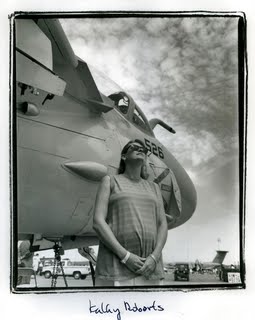 When it first flew in 1960, the A-6 was the smartest airplane in the fleet. An expensive airplane to begin with, 43 percent of the $25 million-a-copy (1990 dollars) Intruder’s cost was accounted for by its electronic equipment – an unheard-of proportion of brains to brawn. It had an onboard computer driving cathode-ray tube (CRT) displays for both pilot and bombardier-navigator, a feature introduced to commercial aviation on Boeing 757-767 airliners 15 years later. Although the first four A-6 Intruders lost in combat over Vietnam were listed as having been downed by anti-aircraft artillery, aviation historians believe three of them were more likely to have been destroyed by their own bombs. The price of pioneering in warfare is usually high, and it was at least mitigated by excellent British Martin-Baker ejection seats that saved the lives of all eight crewmen, two of whom became prisoners of war. One solution was to use explosives to actually blow the bombs off their racks under the wings. Another was to “pop-up” from the low-level run, climb to 2,000 feet, visually acquire the target by rolling the A-6 inverted, and then aim it at the target. A variation is to release the bombs while climbing vertically over the target. Doing a pop-up imposes a four-G load on the airplane and its crew, whose heads, burdened with helmets and breathing gear, become four times their normal weight. Then again, as the Sea-N-Sky Festival air show commentator, a Confederate Air Force Colonel from Arlington, Texas, explained over the PA, when you bomb while flying straight up, “You can be at home sipping a cold beer by the time the bombs go off.” The pop-up bomb run resolved the suicidal aspects of low-level bombing, which had become necessary because North Vietnam’s sophisticated SAM defenses made conventional high-level bombing out of the question. The technique also happened to create a sensational air show routine, “It looks pretty good from the inside, too,” Schork mentions. There was an A-6 parked in front of Whidbey’s operations centre during the air show. Frank Silebi was putting in a long hot day in his polished black boots and khaki flying suit by the Intruder’s nose, telling anyone who would listen that he is part of a naval aviation milestone: “the last class ever for the A-6, “three pilots, one bombardier-navigator, doomed to become carrier qualified anachronisms. Silebi was born in Barranquilla, Colombia, but grew up from an early age in Pennsylvania. He can speak fluent Spanish. When Silebi was in flight t training, flying TA-4J Scooter on and off carriers, the withdrawal date for the A-6 was 1999. By the time he had his naval gold wings, the date had been moved ahead by two years. Flying the A-6 is Silebi’s reason for being in the Navy, and for a while he was afraid he might not be trained soon enough to do it. After all he says, “What’s better than flying low and flying fast?” 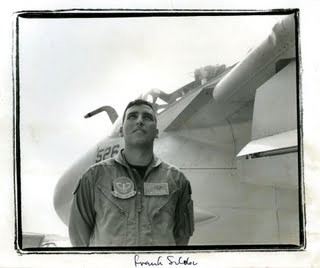 John Schork (43) and the airplane (34) came up together. Their careers are as one. Smart airplane, bright officer. The current Norden Picklebarrel Tropy holder put in three of his four combat tours with VA-95, the Green Lizards, celebrating 50 years of service last October. Schork’s Green Lizard tours have included his top-cover assignment over Saigon. It is now almost 20 years since John Schork made his combat debut ushering in peace over Vietnam in early 1975. The fire of his sunglass lenses lit up to the story as he described his first taste of the Real Thing, the thing he still wins awards training for: “I can remember orbiting Saigon. I could see Tan Son Hhut airbase burning. I can remember the tracer fire coming up against the gathering dusk, and the smoke, and thinking this was a historic evening. We were flying A-6s, loaded with bombs, as cover. Our helos (CH-53 helicopters) were circulating, evacuating people….” In other words, the A-6 was used over Saigon in a fighter’s role, able to fly safely in darkness. The concern was that if any helicopters were shot down that day, the vengeance impulse might extend the war. None were. “It was a dependable airplane,” Schork says, lapsing into an early obituary for the A-6. “I’ve seen this thing come back with one of the horizontal stabilizers gone. It’s a forgiving airplane. It’s practically impossible to spin the airplane. I can take off at Whidbey and on-leg-it to Washington, DC. I have flown the thing trans-Pacific. We flew a strike from the carrier in mid-Pacific and flew 1500 miles to the Hawaiian Islands, at night, and flew back to the ship. That’s when you realize how big the Pacific is. Each of us had our own tanker. That’s you’re you realize what the airplane can do. “ There are plenty of guys at Naval Air Station Whidbey Island who feel the loss of their airplane will leave the world a less safe place. They don’t come out and say so. That would be unprofessional. Their wives are more straightforward on the subject. I remember exactly when I fell in love with the A-6 myself. To me the Intruder and its genius brother, the Prowler, consisted of bulbous noses, bug-eyed and strong but sagging bellies: they were flying dump trucks, worthy of respect but hardly killer sex objects. Infatuation has a lot less to do with looks that with timing and circumstances. It happened four years ago last Saturday. The air show in Abbotsford, British Columbia was over. The star was a MIg-31 Mach 2-plus turbojet dragster, seldom seen in the West until then. It had drawn audible gasps in the finale by flying low directly at the crowds, pulling up, lighting both afterburners, and climbing on twin sheets of flame, scorching the infield. A Mig-31 is fast but cannot turn, and the Mig Bureau’s celebrated chief test pilot, Valeri Menitsky, had wrung everything the big fighter had to give. The Cold War was already history in 1990, although the hour or so I had spent with the genial Menitski, conversing through a dour-faced interpreter, still felt like a handshake over a vast ideological gulf. After getting to know him beforehand, exchanging gifts, watching him muscle his fighter into turns that took him from the Fraser Valley out over the San Juan Islands and return from his routine soaked with sweat, it came as a distinct surprise to me that the A-6 is the mental snapshot I retain from that air show. Perhaps the guys from NAS Whidbey felt a reply was in order. As we were packing our cameras and empty sandwich wrappers, a hard-edged rolling thunder directed our attention to our left. The A-6 in mottled grey war paint was maybe 30 feet off the runway and going to beat hell. Its wing appeared to be exactly at eye level, with its external tanks hung underneath in shadow, tangential to its potbelly. The red anti-collision strobe was blinking away underneath the cockpit. It was flying fast enough to generate white condensation in a vortex off its upper wing roots, an effect heightened by its unique tadpole shape and wide two-man canopy with its art deco windshield frame. 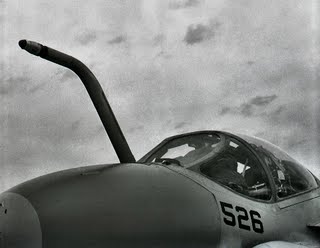 In front of the canopy, the Intruder’s in-flight refueling probe stood up and pointed forward like some trans-sonic insect’s feeler. Nose down, tail up, all business, it looked lethal in a way it never did standing on its landing gear on the flight line. The bombardier-navigator saluted as it passed. The A-6 became a blur in front of our turning heads, pulled up, and in an instant was a T-shaped dot dematerializing through the cirrus. Sean Rossiter is the author of The Immortal Beaver - The World's Greatest Bush Plane, The Otter & Twin Otter and The Chosen Ones - Canada's Test Pilots in Action Sean RossiterCaptain John Schork the Novelist
The A-6 Intruder - My Conflict With War Games
Wednesday, February 17, 2010
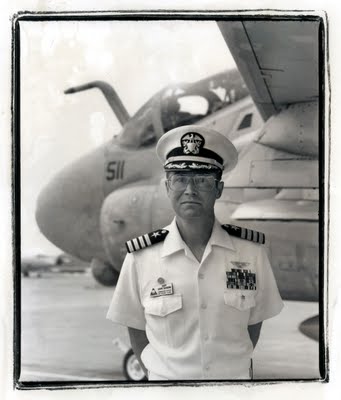 January 27, 1995 January 27, 1995
Alex Waterhouse-Hayward
5909 Athlone Street
Vancouver BC V6M 3ª3
Dear Mr. Waterhouse-Price [sic],
Thank you for your letter of December 14, which reached me today via Simon & Schuster. I apologize for the delay, but sometimes they take a while.
When I looked at the photos I realized you have a rare gift. You are one hell of [frequently used by this author in his novels with the spelling helluva] a photographer. And you are on a good story, which is much bigger than the demise of the A-6. The aftershocks of the collapse of communism will affect many lives, not the least of which are those people who have made a career of the military. They are the most directly affected, but the devastation is just as total on the families of the engineers and technicians of the so-called military-industrial establishment who are also facing career death.
I would like to tell you this is something new, a phenomenon cause by the fundamental changes in the international scene that make the worlds a safer place for free people, but alas, that is not the case. This is the same process that occurred after the American Civil War, World War I, World War II and Vietnam. Downsizing. Institutional stagnation. Until the next crisis comes along--and it will, it always does—we don’t need or want you folks, nor can we afford you, so good-bye and have a nice life. But leave your name and telephone number just in case, okay? Now back to the problem of the welfare mothers.
Sincerely,
Stephen Coonts Back in 1984 I had read a new techno thriller called Hunt for Red October by Tom Clancy. There was another novel (far more satisfying for me) also by Tom Clancy, and co-written with Larry bond, published in 1986, Red Storm Rising in which petroleum shortages usher in a scary and most believable WW III. But it was Stephen Coonts' 1986 novel, The Flight of the Intruder, published, like Hunt for Red October (then considered quite odd) by the Naval Institute which I consumed in one night's reading. Its description on what must be the single most difficult job in the world, to land a jet aircraft on the pitching deck of an aircraft carrier at night, left me amazed. Coonts’(himself a former naval pilot) explanation on the workings of the pilot and his tandem seated BN (bomber/navigator) in the Grumman A-6 Intruder left me with extreme airsickness as I understood that the BN spent most of the time looking down on a radar screen and instruments. If I were to do that in a placid flight on a Boeing 737 I would be sick on the spot! Coonts' descriptions of A-6 Intruder night flights over flack and SAM infested North Vietnam was as realistic as the claustrophobia inducing The Boat by Lothar-Gúnther Buchheim, the cold and misery of Alistair MacLean's H.M.S. Ulysses and Nicolas Monsarrat's The Cruel Sea. The fear in the throat of Coonts' hero Grafton was as real and horrific as the fear and gore of Len Deighton's Bomber. 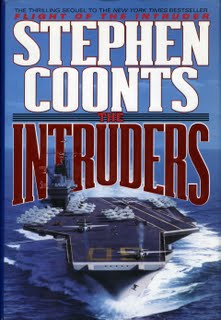 Since I am now a Canadian citizen I have like most Canadians not been a war mongerer or an enthusiast of war. But it is difficult to deny a childhood of playing with swords, cap gun replicas of Western .45s and waging war with toy soldiers on my mother’s lawn. It is difficult to deny the pleasure and awe with which I enjoyed in the 50s my uncle, Luis Miranda’s collection of war-time Life Magazine. I saw the picture of McArthur returning to Leyte there and ads for Buicks that proudly stated that Sherman tanks had Dynaflow automatic transmissions! It is difficult to deny the influence of four years of high school in Austin, Texas and of many trips to the nearby Bergstrom USAF. It was there that I first saw the towering Boeing B-52 and passed my hands on the sharp edged wing of a Lockheed F-104 Starfighter. In the mid 60s while in the Argentine Navy I translated into Spanish the operation and maintenance manuals for the then recently purchased Douglas A-4 Skyhawks. I became intimate with these beautiful (for beautiful they are) airplanes and when the Falklands War happened I was more concerned on the loss of what I considered my airplanes than the death of the Argentine pilots who did well enough and died in equipment that had been obsolete back in my days at the navy. It was difficult to reconcile and understand that my classmates at St. Ed’s in Austin, Texas, as Americans had been part of the Vietnam War that I remember as body count accounts on my weekly readings of Time Magazine. My room buddy John Arnold had been a US Marine who dangled from helicopter cables to save downed flyers in Vietnam. Others from my class died in Vietnam conflicts. My friend grade 9 friend John Straney with whom I had shared my interest in WW II German airplanes and tanks was in the US Air Force in 1967. Of late these classmates have put a face on the body counts and I feel conflicted particularly when I re-read (as I did last week) Coonts’ Flight of the Intruder and its 1994 sequel The Intruders. I cannot so easily dismiss the conservative beliefs of my Texan classmates who own many guns, target practice at least once a week and tell me of their exploits in 'Nam. Who am I to argue after two years of a desk job as a conscript in the Argentine Navy!  Steam catapults make modern Aircraft Carriers possible. Invented by the British during World War II, catapults freed designers from the necessity of building naval aircraft that could rise from the deck under their own power after a run of only three hundred feet. So wings could shrink and be swept as the physics of high speed aerodynamics required, jet engines that were most efficient at high speeds could be installed, and airframes could be designed that would go supersonic of lift tremendous quantities of fuel and weapons. A luxury for most of the carrier planes of World War II, the catapult now was now and absolute requirement. Steam catapults make modern Aircraft Carriers possible. Invented by the British during World War II, catapults freed designers from the necessity of building naval aircraft that could rise from the deck under their own power after a run of only three hundred feet. So wings could shrink and be swept as the physics of high speed aerodynamics required, jet engines that were most efficient at high speeds could be installed, and airframes could be designed that would go supersonic of lift tremendous quantities of fuel and weapons. A luxury for most of the carrier planes of World War II, the catapult now was now and absolute requirement.
The only part of the catapult that can be seen on the flight deck is the shuttle to which aircraft are attached. This shuttle sticks up from a slot in the deck that runs the length of the catapult. The catapult itself lies under the slot and consists of two tubes eighteen-inches in diameter arranged side by side like the barrels of a double-barreled shotgun. Inside each tube – or barrel - is a piston. There is a gap at the top of each barrel through which a steel lattice mates the two pistons together, and to which the shuttle on deck attaches.
The pistons are hauled aft mechanically into battery by a little cart called a “grab”. Once the pistons are in battery, the aircraft is attached to the shuttle, either by a linkage on the nose gear of the aircraft in the case of the A-6 and A-7, or by a bridle of steel cable in the case of the F-4 and RA-5. Then the slack in the bridle or nose-tow linkage is taken out by pushing the pistons forward hydraulically – this movement is called “taking tension.”
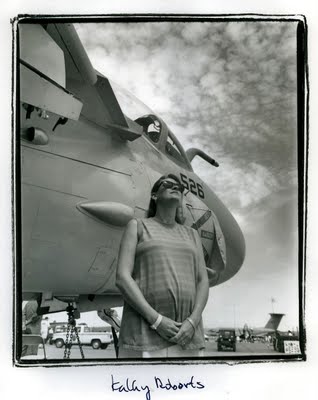
Once the catapult is tensioned and the aircraft is at full power with its wheel brakes off, the firing circuit is enabled when the operator pushes the “final ready” button.
Firing the catapult is then accomplished by opening the launch valves, one behind each tube, simultaneously, which allows superheated steam to enter the barrels behind the pistons.
The amount of acceleration given to each aircraft must be varied depending on the type of aircraft being launched, its weight, the amount of wind over the deck, and the outside air temperature. This is accomplished by one of two methods. Either the steam pressure is kept constant and the speed of opening of the launch valves is varied, or the launch valves are always opened at the same rate and the pressure of the steam in the accumulators is varied. Aboard Columbia, the steam pressure was varied and the launch valves were opened at constant rate.
Although the launch valves open quickly, they don’t open instantaneously. Consequently steam pressure rising on the back of pistons must be resisted until it has built up sufficient pressure to move the pistons forward faster than the aircraft could accelerate on its own. This resistance is provided by a shear bolt installed in the nose gear of the aircraft to be launched, to which a steel hold-back bar is attached. One end of the bar fits into a slot in the deck. The bolt used in the A-6 was designed to break cleanly in half under a load of 48,000 pounds, only then allowing the pistons in the catapult, and the aircraft, to begin forward motion.
The superheated steam expanding behind the pistons drove the length of the 258-foot catapults of the Columbia in about 2.5 seconds. Now up to flying speed, the aircraft left the deck behind and ran out into the air sixty feet above the ocean. When it then had to be rotated to the proper angle of attack to fly – in the A-6, about eight degrees nose-up.

Meanwhile, the pistons, at terminal velocity and quickly running out of barrels, had to be stopped. This was accomplished by means of water brakes, tubes welded onto the end of each of the catapult barrels and filled with water. The pistons each carried a tapered spear in front of them, and as the pistons reached the water brakes the spears penetrated the open ends, forcing water out around the spears. Water is incompressible, water got smaller and smaller, yet as the spears were inserted the escape openings for the water got smaller and smaller. Consequently the deeper the spears penetrated the higher the resistance to further entry. The brakes were so efficient that the pistons were brought to a complet stop after a full-power shot in only nine feet of travel.
The sexual symbolism of the tapered spears and the water-filled brakes always impressed aviators – they were young, lonely and horny – but the sound a cat made slamming into the brakes was visceral. The stupendous thud rattled compartments within a hundred feet of the brakes and could be felt throughout the ship.
Tonight as he sat in the cockpit of an A-6 tanker waiting for the cat crew to retract the shuttle, Jake Grafton ran through all the things that could go wrong with the cat.
The Intruders, Stephen Coonts, 1994And in a later chapter that sheer bolt does break off prematurely which leads to some of the most exciting writing account on how Grafton is able to stop his plane before it rolls: Sliding, turning left and still sliding forward…he felt the left wheel slam in the deck-edge combing, then the nose, now the tail spun toward the bow, the whole plane sliding…
And he stopped.
Out the right he could see nothing, just blackness. The right wheel must be almost at the very edge of the flight deck.
He took a deep breath and exhaled explosively.
His left hand was holding the alternate ejection handle between his legs. He couldn’t remember reaching for it, but obviously he had. He gingerly released his grip.
The Intruders, Stephen Coonts, 1994 My fascination with The Flight of the Intruder led me to go to several air shows at the Whidbey Island Naval Air Station near Oak Harbor in Washington State. I went with my friend Sean Rossiter who like me is an airplane enthusiast. At Whidbey Island I thrilled at watching A-6 Intruders fly. And it was in July 1994, my last visit that I found out that the A-6s where being phased out and replaced by F/A-18 Hornet. I talked to pilots who told me that the thrill (and fear!) of piloting an A-6, very low (skimming the trees) at night and in bad weather could never ever be replicated by the Hornet. In fact to this day the Hornet can not match the Intruder’s range and payload. During its existence as an attack plane (A-6s were never used as fighters but to bomb, strafe military installations and ships) the Intruder could carry a bomb payload that was second only to that of the Boeing B-52. My excitement at seeing the Intruders and taking photographs of the then base commander (who had flown Intruders) Captain, USN John Schork led me to propose to Rossiter that we collaborate on a story and to try to sell it to magazine. We never found anybody interested even though Coonts in his letter to me suggested a few venues. The story died even though Rossiter wrote it. In my files today I found two versions of Rossiter's 6 page story. I called him up for permission to run it. Permission has been granted (story will follow sometime today). Since 15 August 94 when Rossiter wrote his second draft he lost all records of it. The publishing of the story in the blog will be a pleasant and now anticipated surprise for him. 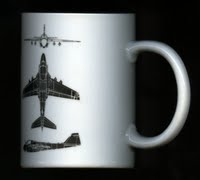 When I re read The Flight of the Intruder (all about Vietnam) and then its sequel The Intruders (no war) I was able to read the technical stuff with far more enjoyment. My ignorance of naval aviation is perhaps the only reason why in my Buenos Aires war games I was never a naval pilot! The splotches of the pictures here are result of bad fixing of my prints. They are Ilford resin coated paper not known for being all that archival. My b+w negatives of these Intruder people are pristine. I like the look of the deterioration. Stephen CoontsAnd would you believe it, Captain John Schork is now an author of aviation novels! Captain John ShorkNot related but still within the subject Sukhoi
Tuesday, February 16, 2010
 The expense of spirit in a waste of shame
The expense of spirit in a waste of shame
is lust in action; and, till action, lust
is perjured, murderous, bloody, full of blame,
Savage, extreme, rude, cruel, not to trust:
Enjoyed no sooner but despised straight;
Past reason hunted, and no sooner had
Past reason hated as a swallowed bait
On purpose laid to make the taker mad.
Sonnet 129, William Shakespeare 1609
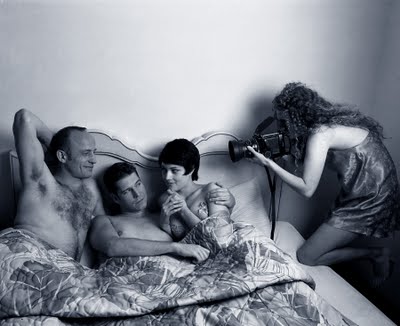
Sometime in spring of 2001 I was approached by Richard Wolfe and Tim Carlson of Theatre Conspiracy with an offer I could not refuse. They were going to mount a performance of Patrick Marber’s play Closer (June 7-16) and they wanted me to take pictures even before the rehearsals began. Wolfe was the director and Carlson the assistant director. The idea is that our pictures (in collaboration with Argentine painter Nora Patrich) would serve as special promotional photographs, as photographs to be used in the program and the photos and collaborations with Patrich (part sketches and part photographs) would hang the night of the opening in large frames.

The actors Kurt Max Runte (as Larry, seen here in a doctor’s smock) Steve Griffith, Michelle Harrison ( Alice seen here as the stripper) and Sarah Louise Turner ( Anna as the photographer) had not really met. Patrich and I put them into a room of the Marble Arch (we had read the script) and set up the shots. We were in the room for four hours. What was really amazing for me is that I had forgotten that actors can act, particularly on demand with short notice! I would give them instructions and they would do as told. I would only need to shoot one or two frames. Runte and Harrison posed in one of the real stripper booths of the Marble Arch. It felt authentic. The amount of emotion we were able to extract from these four was an experience I will never forget.

I have seen some excellent theatrical pictures in Vancouver through the years but just this time I will beat on my own drum to opine that these pictures are really special.
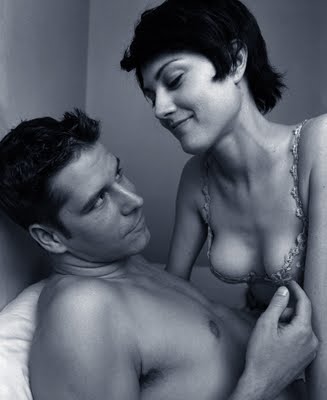
If you read the plot synopsis here you will understand the gist of the pictures and the reason for the camera, the doctor's smock, the mouse and Steve Griffith (Dan) in drag.
Anna. "She has one address in her address book; ours ... under 'H' for home."
Dan. I've cut that line.
Anna. Why ?
Dan. Too sentimental.
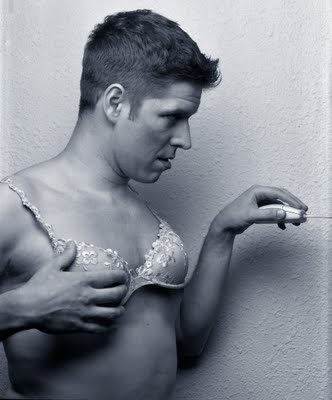 
Dan. What do you want ?
Alice. To be loved.
Dan. That simple ?
Alice. It's a big want.
 
Larry. It's about you, isn't it ?
Alice. Some of me.
Larry. Oh ? What did he leave out ?
Alice. The truth.
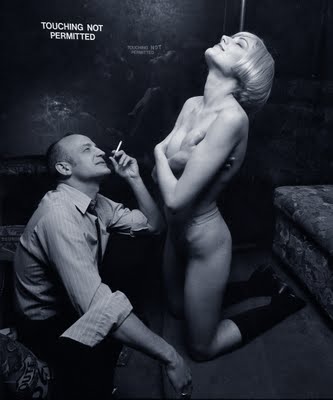
Pluto Platters & Wham-O Blowguns
Monday, February 15, 2010
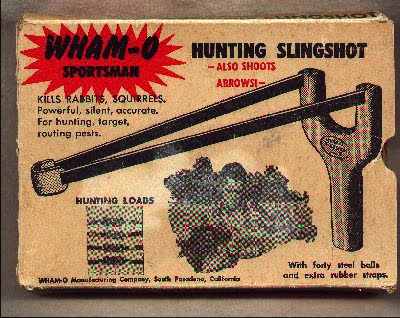 On February 13 I read in my hard copy NY Times: Walter Fredrick Morrison, who at 17 sent the lid of a popcorn tin skimming through the air of a California backyard and as an adult remade the lid in plastic, in the process inventing the simple, elegant flying disc known today as the Frisbee, died Tuesday at his home in Monroe, Utah. He was 90.I was not aware that Morrison’s invention before it was bought by the Wham-0 company in 1958 had been called the Flyin’ Cake Pan, the Whirlo-Way the Flyin’-Saucer and finally the Pluto Platter. I read the obituary with nostalgic interest but I must clarify that I never did master the art of throwing a Frisbee. It may have been sometime around 1959 when the Frisbee arrived to St. Ed’s High School in Austin, Texas. The master of the sailing art was my friend (and now a successful dentist in Houston) Steve Burdick who tried his best to teach me. My expertise with wrist work involved the ping pong paddle. I was one of the best in school in that game. The Frisbee was never my thing and I remember young men throwing them in Kitsilano Beach here in Vancouver in the mid 70s. They often played the game with their dogs. I found the whole exercise kind of silly! My son-in-law Bruce Stewart plays something called Frisbee Golf. While the Frisbee and I never did get along I had an early relationship with the Wham-O company in 1957 when I was a nerdish freshman at St.Ed’s.  Because I was an Argentine born boy who had lived in Mexico so that my accent was a blend of Argentine and Mexican I was considered an outsider by la Raza (those that were either Mexican of Mexican heritage) while the white Texan/Americans considered me a foreigner (even though I, too was white and spoke English). I was in between and part of neither camps. I was left to my own resources.  So I took advantage of the efficient American postal system and became a member of a “club” in which I purchased b+w glossies of airplanes including military fighters, vintage WWI and II plus the more recent jet fighters and bombers. The club also had a new section and I began to collect photographs of what they called guided missiles. I remember the BOMARC and the Nike. I also constructed gadgets. My source of materials for these gadgets was an army surplus store on Congress Avenue that was very close to the Congress Avenue Bridge (before the bats settled in). It was at that store that I bought a special compass that I could adapt into a flying-saucer-spotter. The compass could be opened so I was able to put two electrodes on either side of North. The electrodes I connected to a buzzer that was battery-powered. At night I would position the device under my bed with the compass pointing north. The idea behind the gadget is that many in those flying saucer sighting days had read (as had I) Major Donald Keyhoe’s The Flying Saucers Are Real and Flying Saucers From Outer Space. We were thus aware that the proximity of a flying saucer would affect the magnetic field. This meant that a nearby compass needle would fluctuate. If I had built my gadget correctly the buzzer would sound! What I was not aware until Brother Vincent De Paul, CSC punished me for waking up part of the dormitory one night was that large tractor trailers also modified the magnetic field. Brother Vincent commanded me to disconnect my compass. I shifted my interests to potentially more destructive and dangerous endeavours. I purchased a Wham-O sling shot. I remember when it arrived in a little brown package. You loaded the leather pouch with steel balls or copper BBs. I was soon practicing by the creek with glass beer bottles. 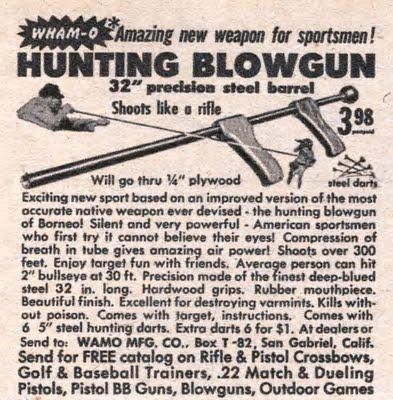 When I saw an ad for the Wham-0 blowgun I rapidly lost interest in the sling shot. It arrived in a longish box. It was partly collapsible in that you connected the rear part with the hand grips to a front part. It came with steel darts that were five inches long. The weapon was silent and I soon came to realize that it was dangerous and could be deadly. Do you think the Brothers of the Holy Cross would have taken it away from me? Absolutely not, as far as Brother Vincent was concerned my “toys” made no noise at night! For a while I practiced to see how much my darts would pierce plywood. But the weapon was useless with beer bottles. I visited the army surplus store and bought a co2 cartridge powered air pistol. I also bought a Spanish American War vintage leather holster (used for carrying a .45 caliber automatic). While many of my classmates became members of the National Rifle Association and joined the Rifle Club run by Brother Stanley Repucci I was never tempted. I perhaps did not know then but I might have already been a liberal who believed in gun control and a Canadian type of socialized health care system. I did not have the credentials to ever be a Texan. But I did practice by the creek to see if I could unholster the gun as quickly as Matt Dillon. Brother Vincent did not take away my air pistol. It was in the summer holidays before I returned to St. Ed’s for Grade 10 that I ran into my first and last incident with my toys. In Nueva Rosita, Coahuila where my mother taught school to the children of the engineers of the American Smelting and Refining Company, we lived close by to a our American bowling alley. I remember spotting the older man who ran it, Juan standing by the door. Without thinking I put a dart into my blowgun and blew. The dart penetrated the door, inches from his face. My mother took away the blow gun. I was too old for an old-fashioned paliza (whipping). Addendum: My son-in-law, Bruce Stewart has informed me that he does not play Frisbee golf. "It is called disc golf because if you were to try to catch one of these it would break your fingers."
Le Roi Est Mort, Vive Le Roi!
Sunday, February 14, 2010
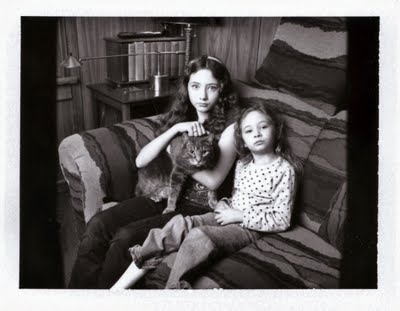 Le Roi est mort, vive le Roi! Friday was indeed a sad day. I took Toby to the SPCA. I almost felt that Toby was apologetic when he soiled his plastic cage in the car. When Dr. Peter Lekkas saw Toby and noticed how far he had deteriorated after a previous visit a couple of weeks ago he looked at me and we both agreed on the course of action. I told Dr. Lekkas that while he dealt with Toby I was going to cross to the adoption side to see if some cat would appeal to me. That being the case I was going to adopt the cat, right on the spot, take him home and present Rosemary with a fait accompli. I did find a cat but I was not able to take him home. The cat I saw was in a sterile quarantine section of the SPCA because many of their cats had suffered from respiratory diseases. They had all been kept apart just in case. In order to see the cats I had to slip into plastic booties and then stand for 30 seconds in a strong disinfectant. There was one cat I immediately noticed. He was a very large gray tabby with almost no markings, with strikingly large eyes of an unearthly yellow green. He was pleasant, low key and affectionate. His name was Kassy which was short for Kassynova [sic]. When I told the woman in charge that I was interested in Kassy she asked me, “Which cat is she?” The folks at the SPCA told me that Kassy, 6, was a one cat household cat and that he was most definitely a house cat. That he was a house cat was evident as the 18 pound cat was certainly overweight. I was further told that he had never been around children. It seemed it was all stacked against me. I told them I wanted to take the cat anyway but I was denied. There is a new regulation that stipulates that if a person wants to adopt a cat in a two-person household the other person has to be there. Dr. Peter Lekkas tried to “fix” the situation by vouching that we were cat people and that I was not married and had no wife! I went home minus the cat. Rosemary reluctantly told me that we would go the next day with the girls but she didn’t think she was ready for another cat just yet. I was thinking that as our financial fortunes diminish going from one cat (an eventually to none) might be our ticket if we plan to travel and or live in a small apartment. Both Rebecca and her mother Hilary said I should get another cat that would be Rosemary’s, as Toby had been. Rebecca was precise, “Abi thinks that Plata (my female cat) is a bitch. She wants a cat of her own.” So we went to the SPCA and all four of us crowded into the room wearing our plastic booties. Kassy sat on our lap, one at a time. He never hissed or in any way showed any inclination to be aggressive with the girls. I said nothing but Rebecca kept harping to her grandmother that this was indeed the cat that was going to be hers. We left the SPCA with our cat. Both Lauren and I decided that Kassy would go back to his original name but spelled correctly. He would be Casanova and we would call him Casa for short. He is big as a house so the name fits. During the whole two days Rosemary was so confused and worried about a possible adoption that she never really stopped to consider that I had returned Friday afternoon with Toby in a box. I opened the box in the garden to find a white towel that was wrapped almost in a ball. I could see Toby’s lovely white front paws sticking out. I had no heart to look any further. I dug the hole and put Toby in it. It began to drizzle as I covered the hole with leaves and dirt. As Rosemary said when I went up the stairs, “Toby is home.” Plata did not know what to do when we arrived on Saturday with Casa. Casa was a bit shy and would hide under the bed (as cats so expertly manage to be in the exact centre so you cannot reach them). But by today Sunday Casa knows where the litter box is. He is friendly with everybody and allows himself to be picked up (if you are able to!) without any fuss. Rosemary had Casa on her chest while lying in bed. She is not too sure about Casa. She likes the traditional tabby cats with lots of markings on the body and those lovely white paws that Toby had. Rebecca pointed out that Casa is indeed a tabby as he has an M above the eyes. I have a feeling that Rosemary and Casa, Casa and Plata, will be friends real soon. We will not forget Toby. Today Rebecca called to say she, Lauren and their Nana wanted to pay us a visit so that Nana could meet Casa. We had hot chocolate and tea. I had the opportunity to take this Fuji instant print so that you can see Casa, at home.
|

 That memory is reinforced every night when I sleep. I move around and my hands get caught under the pillow. My pinkies throb. I have arthritis. At my rate I will soon not be able to prune my roses as the secateurs will be unmanageable in my hands.
That memory is reinforced every night when I sleep. I move around and my hands get caught under the pillow. My pinkies throb. I have arthritis. At my rate I will soon not be able to prune my roses as the secateurs will be unmanageable in my hands.


































